
A sketch of the Kennebec tribe settling along the Kennebec River. (Internet photo)
As previously described, what is now the Town of Sidney, on the west bank of the Kennebec River north of Augusta, began as the western half of Vassalborough, now a separate town on the east bank of the river. (See The Town Line, March 26)
The Kennebec Proprietors hired Nathan Winslow to survey both sides of the river in 1761, and in 1774 they had John Jones survey the rest of the west side to Lake Messalonskee, also known as Snow Pond (and so called in this article). The map and description of Winslow’s surveys in Alice Hammond’s History of Sidney Maine 1792-1992 match the description of Vassalboro: three tiers of long narrow lots west from the river with a rangeway between each tier, an irregular space that Hammond calls a gore between Winslow’s and Jones’ work, then two more tiers of lots.
Sidney’s original boundary was on the west side of Snow Pond, Hammond says; after Sidney separated from Vassalboro in 1792, the new town laid out 10 school districts, and one of them was the area on the west side of “the Pond.” In 1799, she says, that land became part of Belgrade, leaving Sidney with the Kennebec as its eastern boundary and Snow Pond as part of the western boundary.
The name Sidney recognizes British soldier and poet Sir Philip Sidney (1554-1586). Sources consulted offer no reason why it was chosen for a Maine settlement.
Hammond mentions a feature that makes Sidney unusual: the Great Sidney Bog, which is mostly in southern Sidney, on the west side of Bog Road, and partly in Augusta. Hammond calls it a 640-acre peat bog traditionally used for hunting and blueberrying.
On its (undated) Beginning with Habitat website, Great Sidney Bog is called a 605-acre Raised Level Bog and an area of state-wide ecological significance. It is important, the website says, because it is farther south than most similar bogs in Maine and because it provides habitat for deer, wading birds and waterfowl.
[See also: The Kennebec Indian tribe]
The first settlers in the 1760s chose riverside lots. Henry Kingsbury’s History of Kennebec County offers a list of names, starting with John Marsh, whose family still owned the June 24, 1763, deed from Massachusetts when Kingsbury published his invaluable book in 1892.
Neither Kingsbury nor Hammond gives details about the spread of settlement through the rest of the town in the early days, although Hammond mentions a few people settled on the shore of Snow Pond. The first town meetings in 1792 were convened along the river; Kingsbury says the first was in David Smiley’s house, and David Smiley operated the first tavern on what Kingsbury calls the river road (presumably today’s West River Road/Route 104).
To be a voter in 1792 Sidney, Hammond says, one had to be male, at least 21 and possessor of either an annual income of at least three pounds or a “free hold estate” valued at a minimum of 60 pounds.
Hamond says the first meeting elected 32 town officers, some with experience in town affairs in Vassalboro.
The first meeting must have been early in the year, because Hammond says at least four more town meetings were held in 1792. Business at the second meeting in May included electing a four-man committee to reach a final agreement with Vassalboro, presumably on the separation of the two towns.
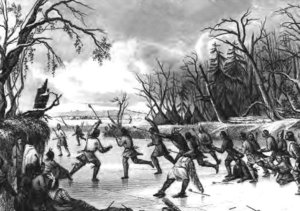
Abenaki Indians engaged in warfare. (Internet photo)
In 1793 voters agreed to alternate meetings between David Smiley’s and Isaac Cowan’s houses. Town meeting voters voted in Massachusetts elections and dealt with local matters, including funding for schools and churches and the laying out of roads.
Voters at an April 1792 school meeting – Hammond does not explain the difference between town meetings and school meetings – approved raising 100 pounds to support 10 school districts, Hammond says. The decision was rescinded at a special town meeting early in 1794; the annual (presumably town) meeting later that year settled on 60 pounds.
Although the Kennebec was the original means of transportation, as mills were developed on tributary brooks, better overland transport became a necessity. What had been foot trails became horse trails, then cart trails and then roads. Hammond says the rangeways turned out not to be the most convenient routes, and the eight-rod rangeway width unnecessary.
The town deeded parts of rangeways to abutters. Roads were laid out across as well as between properties, with landowners allowed to work off part of their taxes by building them. In 1793, Hammond says, voters approved the following (daily?) rates: $1 per man, 25 cents for an ox, a plow or a cart.
Most early industries were sawmills and gristmills producing lumber for frame houses (to replace early log cabins) and grain to eat. Kingsbury says John Marsh built one of each in 1763, on the east (river) side of river road on Bog (later Hastings) Brook. In 1774, he says, a combination of high water and an ice jam washed away both mills and drowned Thomas Clark as he tried to save two bags of meal his family need.ed.
(Observant readers will have noticed that Hammond gives some of her prices in British pounds and some in United States dollars. In Kennebec Yesterdays, Ernest Marriner says that after the new United States government converted to a decimal system, country people had to adapt too. Talking about a doctor in Sidney in the early 1800s, Marriner explains that the man used to charge one British shilling to pull a tooth; he changed to 17 cents American after a dollar was “arbitrarily” set as equal to six shillings, making one shilling one-sixth of a dollar, or 17 cents.)
Continuing north along the Kennebec River, Sidney is bordered by Waterville, like Sidney originally part of its east-bank neighbor, Winslow (see The Town Line, April 2). The two were separated in 1802.
After sharing Winslow’s early name, Ticonic, and then being part of Winslow, Waterville needed a new name in 1802. Ava Harriet Chadbourne’s Maine Place Names says “Waterville” means “a town or city located on the water.” Marriner says several prominent families wanted the new town named after them, and whoever made the decision chose Waterville to avoid offending anyone.
Waterville included what is now Oakland until 1873, when Oakland was set off as West Waterville. In 1883 the name became Oakland (because of its many oak trees, Chadbourne says).
Kingsbury says the Waterville part of Winslow grew faster than the Winslow part, citing population figures, the number of doctors who chose the western shore, early mills and early businesses. Among early settlers’ names repeated in 21st-century street names are Appleton, Boutelle, Cool, Dalton, Getchell, Gilman, Redington, Sherwin and Temple.
Waterville’s first three doctors, all of whom practiced other professions as well, are mentioned in most histories of the city. Dr. John McKechnie (c. 1732-1782) is generally considered the foremost; Kingsbury calls him active and useful.
McKechnie was an engineer and surveyor as well as a medical doctor. Kingsbury says he was a Scotsman who came to America in 1755 and to the Kennebec in 1771, where he surveyed Winslow before settling on its western side. Though his medical career was not a main occupation, he supposedly helped care for soldiers passing through on Benedict Arnold’s 1776 march to Québec. By 1780 he was operating a gristmill and a sawmill on Messalonskee Stream.
Early mills were built on smaller tributaries to the Kennebec, Marriner explains, because the river was too big and too swift for their simple machinery. Most of the streams with waterfalls flowed from the west shore, these smaller, more controllable streams provided better mill sites; so early mills were more numerous in west-shore towns.
Dr. Obadiah Williams (1752-1799), a surgeon in the Revolutionary War, came from New Hampshire to Sidney (according to Kingsbury) or to Mount Vernon/Vienna (according to Marriner) and in 1792 moved to Waterville, Marriner says for business opportunities. He owned a lot that had 40 rods of Kennebec River frontage and extended west to the first Rangeway, including what became Waterville’s business district.
Williams is said to have built the first frame house in Waterville. Marriner claims he was so prominent that in 1802 his was one of the names proposed for the new town.
According to websites, he is buried in Pine Grove Cemetery.
The third notable doctor was Dr. Moses Appleton (1773-1849), another New Hampshire native who graduated from Dartmouth College in 1791. According to the website American Medical Biographies, a Dartmouth classmate named Reuben Kidder had a law practice in Winslow, and in 1795 or 1796 Appleton asked him about Waterville.
Kidder told him it was a town of about 1,000 people, mostly living in log cabins, with six shops; the nearest drugstore was 30 miles away in Hallowell; and Dr. Williams would welcome a younger colleague. Kidder offered Appleton half of the building he was about to build for a home and office.
Appleton came to Waterville in 1796 and never left. Marriner and the website say he got 96 patients the first year, including Dr. Williams, for whom he pulled a tooth. He was active in town affairs, joined the Maine Medical Society early in its life and was admired and respected. (The Maine Medical Society, properly the Medical Society of Maine, was founded in 1820 and stopped meeting in 1845, eight years before the present Maine Medical Association was organized.)
MAIN SOURCES:
Hammond, Alice, History of Sidney Maine 1792-1992 (1992);
Kingsbury, Henry D., ed. Illustrated History of Kennebec County Maine 1625-1892 (1892);
Marriner, Ernest, Kennebec Yesterdays (1954);
Websites, miscellaneous.




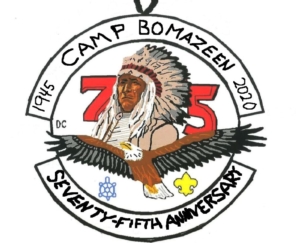
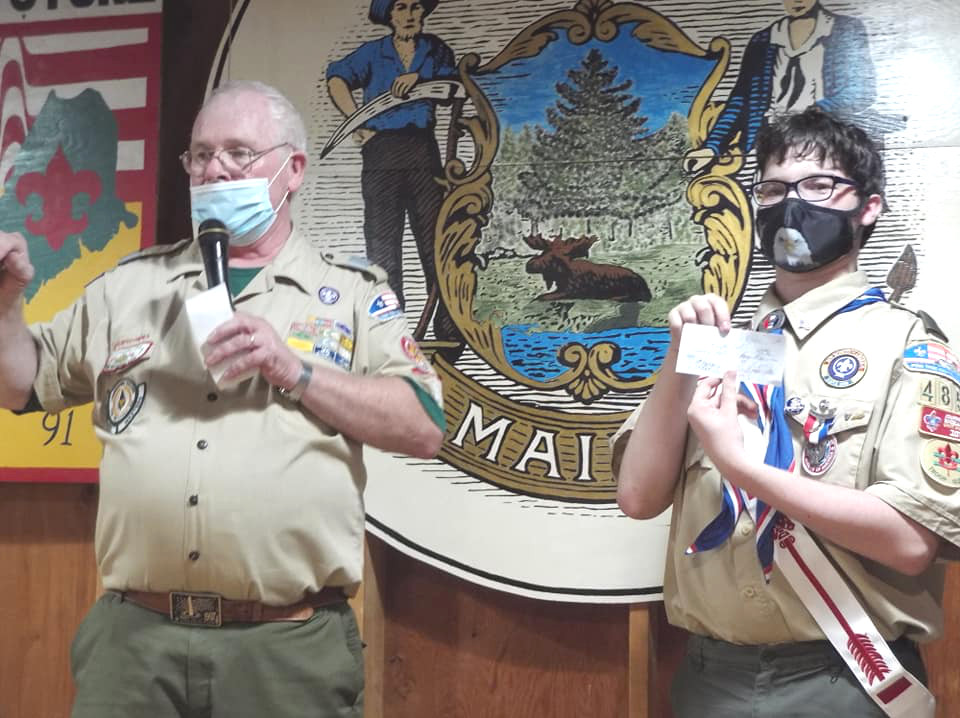


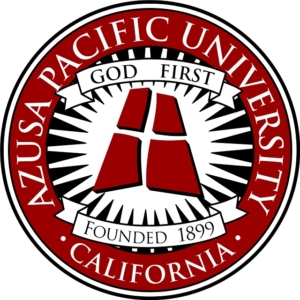 Sidney resident Anna Schutte made the academic deans’ list at Azusa Pacific University, in Azusa, California. An English major, Schutte is honored for a fall semester 2019 academic standing of a 3.5 or better grade-point average.
Sidney resident Anna Schutte made the academic deans’ list at Azusa Pacific University, in Azusa, California. An English major, Schutte is honored for a fall semester 2019 academic standing of a 3.5 or better grade-point average.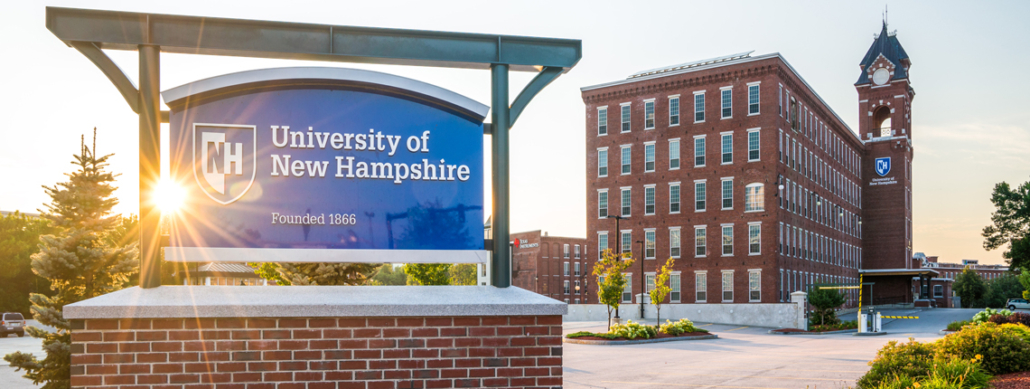 Taylor Ferguson, of Sidney, graduated from the University of New Hampshire, in Durham, New Hampshire, in December 2019. She earned a MS in Occupational Therapy.
Taylor Ferguson, of Sidney, graduated from the University of New Hampshire, in Durham, New Hampshire, in December 2019. She earned a MS in Occupational Therapy.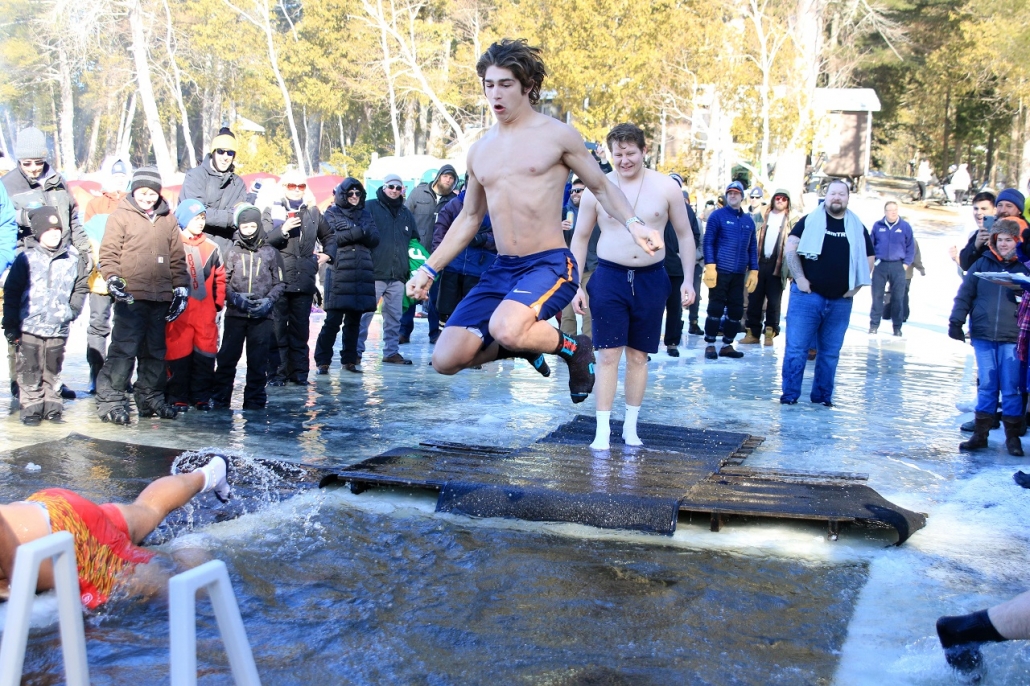
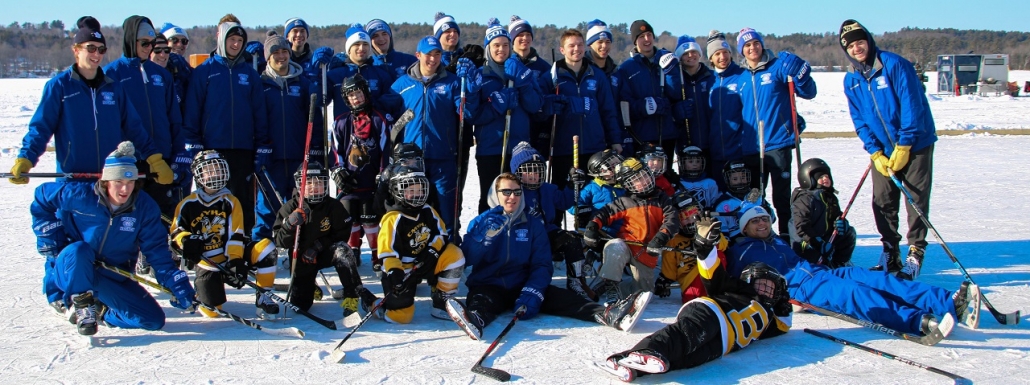


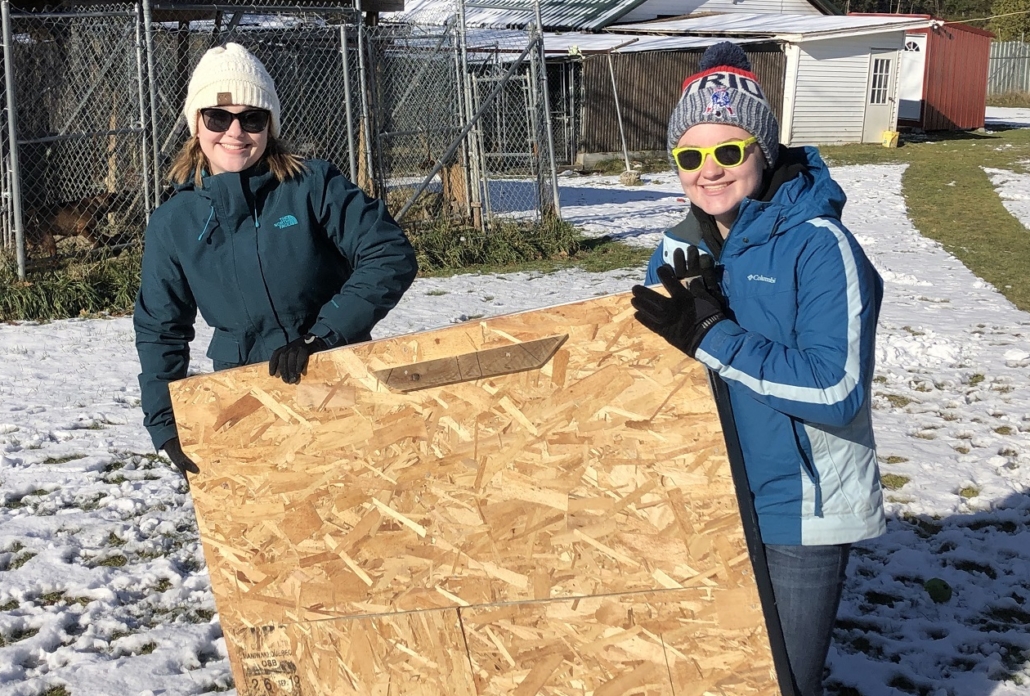



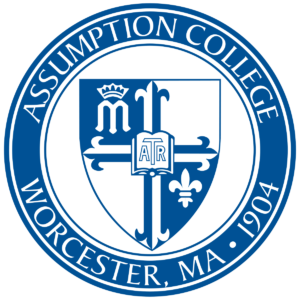 The Assumption Department of Athletics, in Worcester, Massachusetts, has announced that Lauren Pickett, of Sidney, has earned a spot on the 2019 Assumption Women’s Lacrosse team. Pickett, class of 2022, will compete during the Greyhounds’ spring season.
The Assumption Department of Athletics, in Worcester, Massachusetts, has announced that Lauren Pickett, of Sidney, has earned a spot on the 2019 Assumption Women’s Lacrosse team. Pickett, class of 2022, will compete during the Greyhounds’ spring season. Paige McGlauflin from Sidney recently graduated from Emerson College, in Boston, Massachusetts, receiving a BS degree in journalism.
Paige McGlauflin from Sidney recently graduated from Emerson College, in Boston, Massachusetts, receiving a BS degree in journalism.